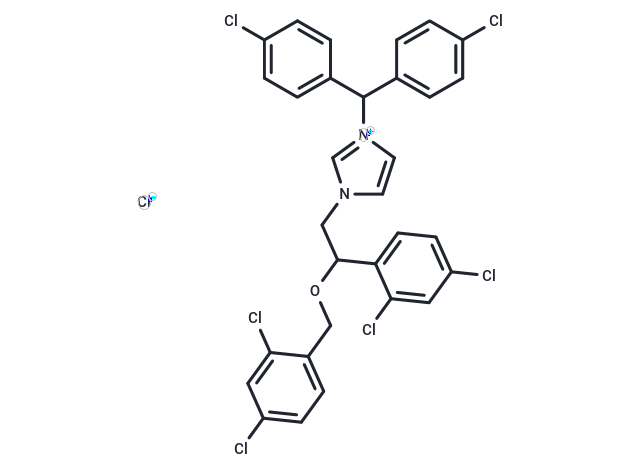Shopping Cart
- Remove All
 Your shopping cart is currently empty
Your shopping cart is currently empty

Calmidazolium chloride (R 24571) is a calmodulin (CaMK) antagonist with a Kd of 3 nM, which inhibits CaM-dependent phosphodiesterase (IC50 = 0.15 μM) and calmodulin-induced activation of erythrocyte Ca2+-transporting ATPase (IC50 = 0.35 μM). It also induces apoptosis in certain cancer cell lines.

| Pack Size | Price | Availability | Quantity |
|---|---|---|---|
| 5 mg | $57 | In Stock | |
| 10 mg | $89 | In Stock | |
| 25 mg | $148 | In Stock | |
| 50 mg | $226 | In Stock | |
| 100 mg | $337 | In Stock | |
| 200 mg | $491 | In Stock | |
| 1 mL x 10 mM (in DMSO) | $87 | In Stock |
| Description | Calmidazolium chloride (R 24571) is a calmodulin (CaMK) antagonist with a Kd of 3 nM, which inhibits CaM-dependent phosphodiesterase (IC50 = 0.15 μM) and calmodulin-induced activation of erythrocyte Ca2+-transporting ATPase (IC50 = 0.35 μM). It also induces apoptosis in certain cancer cell lines. |
| Targets&IC50 | PDE (CaM-dependent):0.15 μM, Calmodulin:12.69 μM(mouse E14 ESCs), Ca2+ transporting ATPase (erythrocyte, Calmodulin-induced):0.35 μM, Calmodulin:8.18 μM(mouse F9 ECCs), Calmodulin:3 nM(kd) |
| In vitro | Calmidazolium chloride also induces apoptosis in certain cancer cell lines. Calmidazolium chloride (3, 5, 7, 10 μM, 30 minutes-24 hours) inhibits the growth of mouse F9 ECCs [2]. |
| Alias | R 24571 |
| Molecular Weight | 687.7 |
| Formula | C31H23Cl7N2O |
| Cas No. | 57265-65-3 |
| Smiles | [Cl-].Clc1ccc(cc1)C(c1ccc(Cl)cc1)[n+]1ccn(CC(OCc2ccc(Cl)cc2Cl)c2ccc(Cl)cc2Cl)c1 |
| Relative Density. | no data available |
| Storage | Powder: -20°C for 3 years | In solvent: -80°C for 1 year | Shipping with blue ice. | |||||||||||||||||||||||||||||||||||
| Solubility Information | DMSO: 100 mg/mL (145.41 mM), Sonication is recommended. | |||||||||||||||||||||||||||||||||||
Solution Preparation Table | ||||||||||||||||||||||||||||||||||||
DMSO
| ||||||||||||||||||||||||||||||||||||

Copyright © 2015-2025 TargetMol Chemicals Inc. All Rights Reserved.